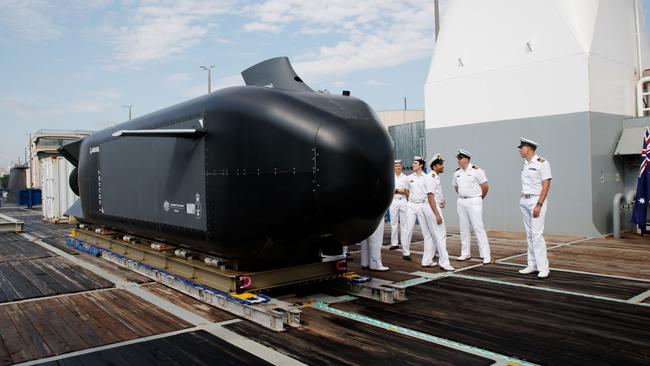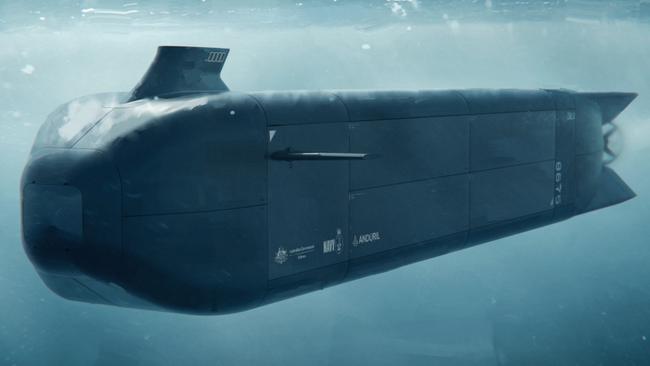Australia unveils cutting-edge ‘Ghost Shark’, an unmanned underwater drone tipped to reshape warfare
As technology develops rapidly, militaries are investing billions to stay ahead of the curve. But Australia’s latest addition to its military arsenal is downright spooky.

Australia and the United States have recently unveiled unmanned underwater vehicles (UUVs) prototypes that prove we are indeed living in a sci-fi future.
The new UUVs, Ghost Shark and Manta Ray, mark a significant shift in undersea warfare by offering a wide range of new capabilities for militaries to reduce human risk in times of conflict.
As technology continues to develop at blistering speed, militaries are pouring untold billions into staying ahead of the curve and signal to potential adversaries that they mean business.
Unmanned drones have become a staple of modern warfare and have been tipped to eventually eradicate the need for humans on the battlefield. The delicate flesh and guts of military personnel will instead be several kilometres away, pushing buttons and directing the flow of battle behind inches of protective steel.
The US has showcased the terrifying potential of military drones extensively throughout conflicts in Iraq and Afghanistan, attracting heavy criticism from humanitarian groups who say they cause excessive “collateral damage”.
More recently, the world has seen the devastating capabilities of drones in the Ukraine conflict, where unmanned devices have been employed to travel above enemy lines and drop bombs on soldiers underneath.

But there’s a brand new challenge when it comes to unleashing drones under the sea.
Unlike aerial and surface drones, underwater drones face unique challenges due to the ineffectiveness of satellites and radio waves in water.
This is compounded by factors like water temperature, salinity, and depth that affect data transmission.
Enter the Ghost Shark and the Manta Ray.
Described as “the most advanced undersea autonomous vehicles in the world”, the cutting-edge underwater drone has features a modular design for a wide variety of missions.
For Australia specifically, Ghost Shark is expected to be used to “counter China’s encroachment into international waters” and patrol waters along our vast coastline.
Australia’s defence department says the undersea drone would provide its navy with “a stealthy, long-range autonomous undersea warfare capability which can conduct persistent intelligence, surveillance, reconnaissance and strike”.
Billed as “a modular, multipurpose capability that can flexibly respond”, the Ghost Shark has been sold as an essential tool for protecting Australia,
“We are a nation girt by sea, and the Ghost Shark is one of the tools we are developing for the navy to patrol and protect our oceans and our connection to the world,” Chief of Navy Vice Admiral Mark Hammond said.

“For the US, the Manta Ray could used globally. With its ability to be packed up and moved quickly, and its capacity to hibernate for long periods at the bottom of the ocean, it could be sent anywhere and pre-deployed ready for activation when needed,” Dr James Patton Rogers, a drone warfare expert and executive director of the Cornell Brooks School Tech Policy Institute in New York, said.
“As for the Royal Australian Navy (RAN), well their drone is destined for the territorial waters around the vast Australian coastline, and when needed, the further waters of the Pacific to counter China’s encroachment into international waters.”
Dr Rogers addressed the question we’re all thinking — just how foolproof are these deadly “autonomous” systems?
“One of the most worrying characteristics of both drones is that they are far more autonomous than the underwater systems of the past. With increased levels of autonomy, comes less human control, a factor that may lead to machine errors or riskier deployments that could escalate existing tensions,” Dr Rogers added.
Global race for drone superiority
Both the US and Australia are focusing on rapid development and deployment of underwater drone technologies to maintain a technological edge.
But China is also advancing in UUV technology and is now believed to be testing UUVs equipped with torpedoes after pushing ahead with development for over 15 years.
Military analyst HI Sutton, who is also the author of Covert Shores, recently reported that Chinese defence exports company Poly Technology had unveiled its UUV-300 family of extra-large unmanned underwater vehicles, which are about 12 metres long and two metres wide and appear able to carry up to four torpedoes and mines.
“We are witnessing a technological revolution which is reshaping naval warfare,” he wrote.
“Unmanned underwater vehicles are developing at an incredible rate, and it is increasingly likely that they will be armed.
“Based on drones in the water, and efforts at defence shows, China is leading the world in this emerging technology.”
Other nations including Canada, France, India, and the UK among others are also developing UUV capabilities, indicating a global trend towards enhancing undersea warfare technology.
A$140m deal will see three Ghost Shark extra-large autonomous undersea vehicles (XL-AUV) built within three years. The agreement comes at a precarious time as tensions continue to escalate throughout the Pacific, with all eyes focused on China and its ambitions to claim Taiwan as its own.

Dr Kyle Woerner, program manager for the US Defence Advanced Research Projects Agency (Darpa) says Manta Ray is being “rapidly assembled” and will be ready for real-world operations imminently.
“Our successful, full-scale Manta Ray testing validates the vehicle’s readiness to advance toward real-world operations after being rapidly assembled in the field from modular subsections,” he said.
“The combination of cross-country modular transportation, infield assembly, and subsequent deployment demonstrates a first-of-kind capability for an extra-large UUV.”
“Once deployed, the vehicle uses efficient, buoyancy-driven gliding to move through the water.
“The craft is designed with several payload bays of multiple sizes and types to enable a wide variety of naval mission sets.”
More Coverage
Originally published as Australia unveils cutting-edge ‘Ghost Shark’, an unmanned underwater drone tipped to reshape warfare





